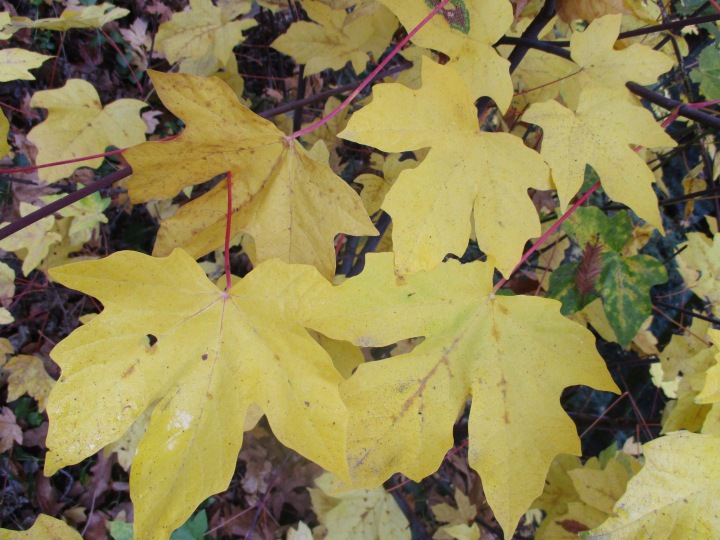The merely adequate color among the sweetgums early in the season suggested that color would be insipid this year. Then, the weather did something that set it all off. There was too much autumn foliar color this week to select just six pictures. So, I didn’t. These six are only the first of four groups of six. It would not be practical to post a group weekly for four weeks, particularly since some of the colorful foliage in these pictures was dislodged by generous rainstorms shortly after the pictures were taken. There will be very little foliage left by the time the last group of six posts. Instead, two groups of six will be posted presently, and the other two groups of six will be posted next Saturday, before they are two weeks old. I hope this does not violate any rules.
All six specie in this first group happen to be locally native. They are also all yellow, which is the standard color here. Regionally, there is not much orange or red. The thimbleberry in the first picture is rather pale yellow, but that is more color than it typically gets. Of these six, the thimbleberry is also the only species that does not grow as a tree, or a shrub like the hazelnut of the second picture. The hazelnut happens to be a Western hazelnut. The cottonwood happens to be a black cottonwood, although I would not know what distinguishes it from any other cottonwood. The sycamore is more specifically a California sycamore, which really is quite distinct.
1. thimbleberry
2. hazelnut
3. cottonwood
4. sycamore
5. boxelder
6. bigleaf maple
This is the link for Six on Saturday, for anyone else who would like to participate:
https://thepropagatorblog.wordpress.com/2017/09/18/six-on-saturday-a-participant-guide/
It’s hard to imagine an autumn w/mostly yellows, coming originally from Appalachia. When my son was still in a car seat, he said as we drove home one day, ‘The trees look like a box of crayons.’ I would imagine, tho, that your light would be a bit different than ours was in the mountains. You’ll have to give us a group shot at some point so those of us from up the holler can see what it’s like for you big city dwellers. 😉
LikeLiked by 2 people
Big City? These pictures were taken a few miles outside of Felton in the Santa Cruz Mountains. I would have gotten more color if I got the pictures in Los Gatos or San Jose where all the fancy exotic species are. I saw some exquisite Chinese pistache, but could not get pictures while driving, and did not bother to pull over. Sadly, when I go to San Jose, I only get as far as the western and southern suburbs, without getting all the way downtown. I really should get more pictures there! I want to get pictures from the summit of Mount Umunhum because it is such a nice view. However San Jose is not much to look at from up there.
LikeLike
Interesting you say ‘Regionally, there is not much orange or red’ We are surrounded by eucalyptus, palm and pine trees so we don’t see much colour change now. I love the russet colours of autumn and one thing I miss about the UK.
LikeLiked by 1 person
Your region probably has a similar set of climates as our region. (I am not familiar with your region though.) The forests of the Santa Cruz Mountains are dominated by redwoods and Douglas fir, without many deciduous specie. Poison oak is the only native that reliably turns red. The exotic specie that provide such excellent color were probably popularized by those from the East. Most people in our region are from somewhere else.
LikeLike
Had to google thimbleberry, great name! Thanks for sharing these natives, an education. 🙂
LikeLiked by 1 person
You are welcome. Thimbleberry is available from a nursery in Washington, but there are better berries to grow. It is not very productive, and is really not very good. I just happen to like it where it grows wild. There is quite a bit of it at work.
LikeLiked by 1 person
It’s gratifying to see so many native trees turning color. Yellow is the predominant native fall color in central Texas, too.
LikeLiked by 1 person
I am told that yellow is common in milder climates. However, yellow is also prominent on the summit of the Sierra Nevada and in the Reno Area. The oranges and reds in western Oregon and Washington are from exotic specie. I wrote an article a while back about how regional some colors are.
LikeLike